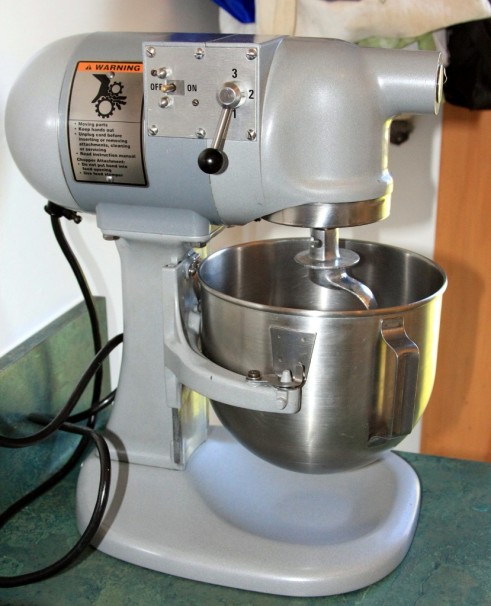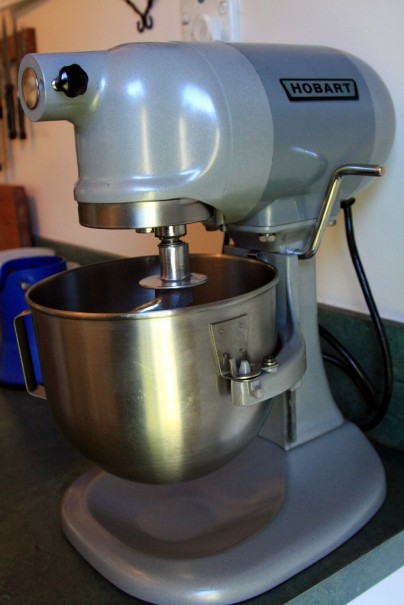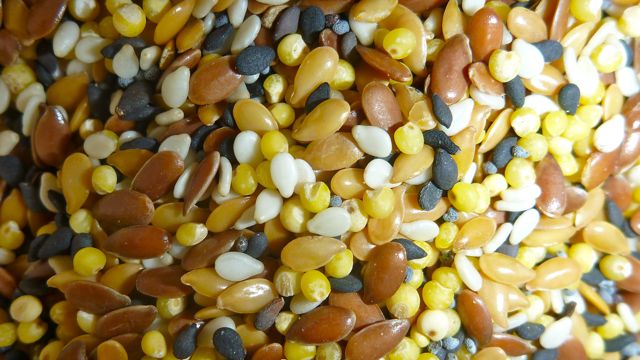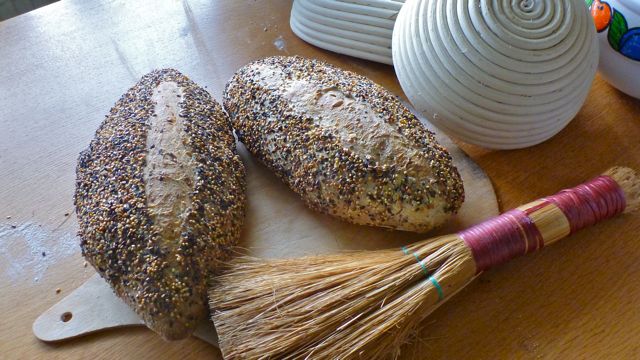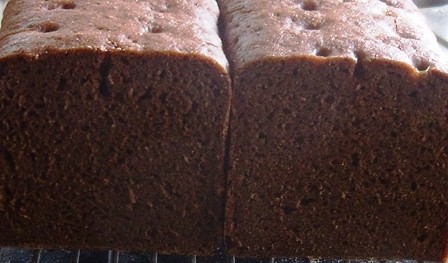
Hobart N50 restoration experience
As a followup to my original N50 thread: http://www.thefreshloaf.com/node/23049/n50-arrivednow-refurb
I'm reporting my experiences stripping down and refurshing my recently-acquired second-hand Hobart N50 mixer (which now will sit alongside my DLX2000). Hopefully it will be useful to anyone else taking this (not too difficult) project on. Unfortunately I didn't take any before pictures (lazy me!), but it was in somewhat beaten-up shape with well-worn paint over most of the base. A nice collection of photos of another person's strip and rebuild can be found here: http://www.flickr.com/photos/zug/sets/72157622051782719/
Parts were missing - the rubber feet, attachment cap and thumbscrew, no dough hook or beater attachment. The Hobart logo sticker was worn. The gear cover plate was warped. The bowl latch spring was broken. She did run, and run smoothly in all gears, but I had always bought it with the goal of a full tear down, repaint and rebuild.
The N50 service manual helped a little, but it is definitely doable without it. It has some useful tips, such as how to split the motor and transmission housings from each other and also how to adjust the transmission for smooth, quiet operation. The pictures/photos are also helpful. It's worthwhile having in additon to the parts diagrams freely available from Hobart.
Firstly, I ordered all of the missing / worn / broken parts. So far so good. As discussed in the thread above, I ordered some Morey synthetic 'blue' food grade grease (expensive - and incorrect - see below). During the strip down, which is mostly a methodical and logical process assuming you have the usual basic tools, patience and a modicum of mechanical knowledge, all went well. You will need some pin punches to drive out the various shaft pins. Other than that, no special equipment needed. The technique in the service manual of hitting the accessory hub attachment with a hammer in order to separate the motor housing from the gear housing is very worthwhile.
The most major problem in the rebuild occurred at this stage: having removed the motor from the housing, I accidentally dropped the housing on the concrete floor! It was immediately obviously dented - ouch! I completed the tear down, removed all of the old (brown, discoloured) grease from the gear housing and took all of the paintable parts to the powder coaters. There, we discovered that the motor housing wouldn't mate properly to the gear housing due to the dent. Popping across to the engineering shop, I thought all was a relief, as they managed to gently tap the housing back into what looked like was the correct shape, as it aligned and fitted once more to the gear housing. Whew (or so I thought). Got the bits back from the powder coaters, and the bowl lift handle back from the metal re-platers (it's nickle, in case you're interested). Also got some new decals printed using a Hobart logo online: http://en.wikipedia.org/wiki/File:Hobart_logo.svg
I then reassembled the gears and transmission and packed it with the Morey synthetic blue... some disgustingly sticky, tacky stuff. Now the real pain - the stator wouldn't fit into the still-distorted motor housing - arrrrgh! It's such a tight fit with no tolerance for variance. I tried filing the fins off the inside of the motor housing - and did get it to fit - but of course the rotor then wouldn't line up within it, while still rotating freely with the starter housing on. Realising that I would need a new stator housing was painful in the extreme - but that's what you get for dropping the most expensive piece of the mixer! Determined to see the project through I bit the large bullet and ordered a new housing which arrived in due course. I finally refitted the the motor and connected it all up. Hit the start switch to test... A loud "hummmmmm", but no rotation!! It turns out two problems were occurring:
1) The blue synthetic morey grease was just too tacky. Although it's a NLGI grade 2 viscocity (the correct one), it is extremely tacky stuff. Changing to a different synthtic but soapy-type grease (similar to the original stuff, but synthetic) - hooray!
2) The contacts on the start switch (not the on-off switch, but the switch at the rear of the housing) were not being adequately compressed. I'm not sure why this is, but I have managed to shim between the rotor and switch so that it turns on and off. It's a fine balance between the mixer turning on properly and having the contacts too close so they're shorting. One day I might take it to the local mixer service agent for a quick look, but for now it's working just fine.
[UPDATE 26/12/15: the problem with the starter motor was eventually traced to needing a shim (metal washer) on the shaft of the rotor, in the motor housing. Finally working this out had two advantages as the rotor is now correctly positioned a few mm's further to the rear of the mixer. One, the starter works first time, every time without shims. Two, the (17T) drive pinion doesn't strip the (49T) main gear. Don't ask how I found out this was the problem, except know that it cost two replacement main gears to figure out. To assist, the location of the shim sits at part #18 on this diagram: http://thesmartpartsestore.hobartservice.com/category/7939/motor-parts and is listed as "spring, loading" (SL-005-10).
For older model N50's, the location of the shim is at part #14 & 15 on this parts diagram: http://thesmartpartsestore.hobartservice.com/category/7926/motor-parts. Part numbers are WS-007-21 and/or WS-007-19.
I made the first batch of pizza dough and a sourdough bread with it yesterday - and it is a fantastic mixer. It's less work than my DLX2000 - in fact it's no work at all, in that I don't have to babysit the initial process to ensure ingredients are properly incorporating, or ensure the dough is still rotating around the bowl properly. I look forward to trying it out with drier pasta and bagel dough later this week.
As you can see from the photos below - it's a custom two-tone colour, since I couldn't be bothered getting the new motor housing poweder coated in the same colour as the other bits I'd gotten done. I like the effect, I've decided! The new motor housing also came with the warning plate attached, and has a larger bolt at the front corner - visible in the first picture - holding it onto the column (which necessitated tapping a larger 3/8th" hole into the column).
Overall, it's been a fun project (dropped housing notwithstanding). I've learnt a lot - and can now pull the mixer to bits in about 5-10 minutes.
